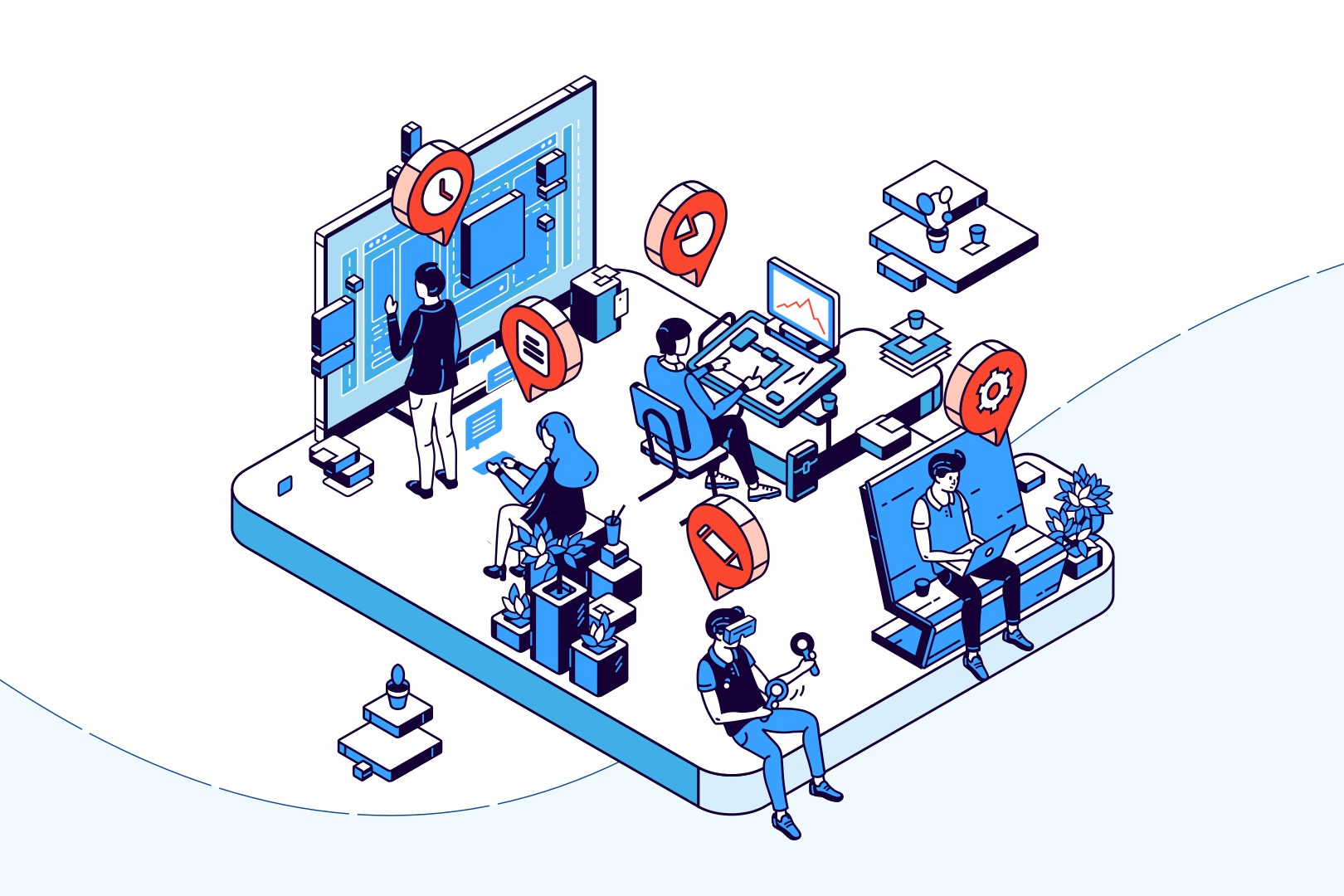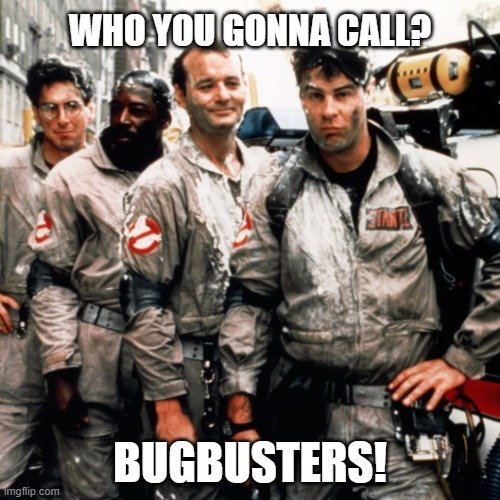16 June 2020
Software development team structure – who brings what to the table?

Software development might sound a little bit like black magic. A bunch of strange words and terms you are sometimes not even completely sure how to pronounce. It‘s easy to get lost in the midst of project team roles and responsibilities in software development, especially if you are a non-technical product owner kickstarting their first IT project. In this article, we’ll start with the basics and answer the question: who does what in your software teams?
You must gather your software development teams before venturing forth
It is a relatively common scenario: you (a client) choose a software development company and come to the first software consultations with your business idea, searching to hire a do-it-all person. It’s “one project for one team” after all. Then after an initial project review, you learn that the team composition should include at least four to six people. You might ask yourself, “What does a software development team do anyway that I need so many people?”, “Why can’t I hire just one person to do the project?”,”Is this how you regularly build software development team?”, “What’s even the difference between all these teams? “, “Am I being ripped off?”.
The reason why a single person is most often not enough to create a development Agile team structure is the fact that the world of software development is vast. Nowadays, there are dozens of different technologies, programming languages and tools being used for various purposes. From making your browser display the right colours, through managing how you store data and do calculations, to making sure that your product is secure and reliable. Even Steve Jobs wouldn’t be able to do it all on his own without a proper software engineering organizational structure!
This is why software companies create interdisciplinary software development teams structures with various specialists and sub-teams to cover all grounds. Below you’ll find descriptions of the most common software development team members in an Agile software development team. After reading this article, you’ll know what to expect when you come to your first software consultations and be well-prepared to kickstart your project.
So let’s see who’s who among members of a software development team.
💡 Read more:
Frontend Developer
TL;DR: Frontend developer creates the part of your application that the users see and directly interact with. They make sure the experience is equally smooth and user-friendly to every person who uses the app.
Every single thing that your users see was created by the frontend developer. I believe it’s enough to convince you about the importance of their role in the product development software team structure. They make sure that your users have a smooth experience without any lags or unpleasantries. Texts, buttons, navigation bars, animations… The quality of literally everything your user interacts with depends on the skills of your frontend developers. The hardest part of their job is to make sure every single user gets the same experience – whether they use Edge or Chrome, computer or phone, Android or iOS. Considering how many browsers, phones, smartwatches and other smart-stuff we operate on – it’s a massive job. Frontend developers are trained to be browser charmers and masters of resolutions. Without them, we would be forced to write in the command line on black&white displays to do anything on your computer.
Related tools and technologies for a Frontend team: JavaScript, HTML, CSS, React, Vue, Angular, React Native, PWA, RWD, Web Browsers.
💡See also:
Backend Developer
TL;DR: Backend developer is responsible for everything that is under the hood of the application, and they are your chief problem-solvers.
The primary role of the backend developer in the software development team is to be Chief Technological Problem Solver. It’s the person who writes complex and sophisticated algorithms and application logic that makes all the magic happen under the hood.
Backend developers make sure your product not only looks amazing, but has an efficient, yet powerful engine. People often think that backend developers just write code. Wrong! They plan and develop the whole application architecture, decide which services and databases should communicate together, how API and external integrations should work and how to make sure the product is secure and stable.
They are consultants, not just coders. A good backend developer not only implements what they are told to but also looks for the most efficient ways to solve a given problem. For example, if you ask your BE developer to implement a particular database, and the developer knows a different solution will work better for your app, they will surely convince you to consider another option. Sometimes the idea you have might be time-consuming to implement but the same effect can be delivered faster using a different approach – backend devs will know it.
All you need to do is to define a problem/the desired effect, and a backend developer will find the most efficient solution to implement that suits your needs. That’s how our backend services work.
Related tools and technologies a Backend team: Node.js, PHP, Databases, SQL, Algorithms, Microservices, Architecture.

Quality Assurance Engineer
TL;DR: QA Engineers make sure that your application is bug-free, has adequate support across all devices/browsers, and meets all the requirements.
The world of software development is a complex and error-prone area, and even the most skilled software developer is not able to implement perfect solutions by themselves. This is why every software development team can benefit from a Quality Assurance Engineer on board.
What do QAs do? To put it simply, they spot the bugs and problems before your users do. While testing your application, QA specialist pays attention to performance, security, usability, portability, and looks of the application from the end-user perspective. They are not just testers, they make sure implemented features meet the requirements (which they help to describe beforehand anyway), write documentation, create test cases, and proactively contribute to establishing the best development practices in the project. Their role is critical in delivering the high-quality product, seamless end-user experience and fulfilment of project requirements. In the long run, not only are they time-savers, but also irreplaceable headache-savers.
Related tools and technologies a QA team: QA Touch, Postman, Test Flight, Confluence, Burp
Do you need a complete development team?
As a custom software development company, we’re here to help you. Schedule a free consultation with our experts.
Quality Assurance Automation Engineer
TL;DR: QAA Engineers write automated tests – small programs that run in the background and constantly test your application, so if something goes wrong, you will know what immediately.
While Quality Assurance Engineer makes sure every new feature is tested properly, sometimes previously implemented things might break. It could be API key/external plugin depreciation, or just something went wrong with deploying a new feature. It’s physically impossible for your QA to do thorough testing of the whole product every single day. So you can either wait for your users to report bugs… or engage a Quality Assurance Automation Engineer.
QAA’s responsibilities include designing and developing automated tests such as “end to end tests” that simulate real user’s behaviour, and if something goes wrong, these tests inform the team about an error immediately. It’s like using a magic wand to make the app test itself all the time.
Well, almost like a magic wand… Not everything can be tested automatically so you can’t just put an automated test on every line of code and ditch your QA. Implementing automated tests is hard, really hard – they should be reliable, maintainable, and give quick feedback. What’s really easy though, is to create a test that not only doesn’t prevent problems but generates them. A good QAA will analyse your app and recommend which features should include automated tests, and which shouldn’t to ensure the best ROI there is. A skilled QAA will make sure that you save as much time and money as possible for testing/bug-fixing.
Related tools and technologies a QAA team: JavaScript, Kakunin, Cypress, Puppeteer, Protractor, Artillery, Appium, Web Browserm, Apptester

💡 See also:
DevOps Engineer
TL;DR: DevOps specialists make sure that your solution is working 24/7, is cheap to maintain, easy to upgrade, accessible, and can sustain sudden user activity spikes as well as earthquakes.
So your team has built a modern and amazing application. You asked a group of friends to test it and they immediately fell in love with it. You are ready to show your new creation to the whole wide world, all you need to do is to release the app and watch your bank account explode with profit. Nothing can go wrong, right? An hour after making your app available, you realise that the app is 10 times slower than when you tested it, people from other countries need 10 seconds just to display the main page, and worst at all, the app already crashed… seven times… in 15 minutes. It’s not a horror story, it’s a poorly architected/not optimised/legacy infrastructure. And nowadays, two years old might already be considered legacy.
Solving the aforementioned problems is a task for an infrastructure commando that is not afraid of new challenges – DevOps Engineers! Their job is to take your infrastructure to the next level. Infrastructure as a code, automated processes, scalable, robust, and tailored cloud solutions – it’s their bread and butter. DevOps Engineer makes sure your application is fast, secure and accessible for people from all over the world. Your app needs to handle sudden spikes in user activity without being overloaded and stay online even if the whole servers’ warehouse is on fire.
You’re probably asking yourself “will this cost me my kidney”? Here comes the best part – a skilled DevOps Engineer will make sure that your infrastructure scales up and down when necessary, depending on your needs. You’ll only pay for what you actually need and virtually use. This gives you the sweet spot, enabling both low-cost and high-performance at the same time. In the long run, DevOps’ role is to make sure, that with every $1 invested in DevOps you get more than $1 of ROI.
Related tools and technologies a DevOps team: AWS. Azure, Cloud Computing, Docker, Continuous Integration/Delivery, Kubernetes, Ansible, Terraform.
Product Designer
TL;DR Product Designers help you to transform your product vision into user-friendly designs and create user journeys optimised for the best user experience and highest conversion rates.
You might have heard of them under titles like UX designer, UI designer, information architects, user-pleaser, and many more. Application development team roles require Product Designers. They are key players in making sure the product you build succeeds. People tend to think of them as graphic artists that create nice looking designs. While it’s true, Product Designers make sure the feel and look of your application and the overall user interface is as sharp and eye-pleasing as possible, it’s not their only responsibility. They will be your team members through the whole software development process, from translating your business goals into functional user experiences, to analysing, evaluating and enhancing those experiences over time.
To the surprise of many, they are also masters of data – they notice every change in conversion rates, click rates, etc., make conclusions and propose solutions to make sure your metrics nourish your business objectives. If you want your users to fall in love with your products, and most importantly, convert through your sales funnels, then product designers are must-have members of development team you’re creating.
Related tools and technologies a Product Design team: Sketch, Figma, inVision, Zeplin, Adobe CC, Story Map, Principle, Piece of paper, Pencil

💡 See also:
Project Manager
TL;DR: A person that thinks about everything that can go wrong in the project and makes sure it doesn’t, so your project is delivered on time and budget.
Project Managers make sure that the project is on track which is a tough nut to crack when it comes to IT software development. They make sure the team is motivated and highly-performing, risks are identified and monitored, and that highest development and communication standards are followed.
Project management is your bridge between the world of business problems and IT jargon. Being with one foot in the software development team, and with the other on the business side working as your consultant, a PM has a unique perspective on the product and process. When something unexpected happens, which can be as trivial as a team member falling sick, or as serious as the application not working, a Project Manager makes sure that the problem is solved efficiently and if possible, prevented in the future. They also constantly investigate the whole development process and look for improvements, to make sure the team delivers more value faster in each iteration. Having proper project management in your team allows you to focus on your product and business instead of on keeping track of every little detail.
Related tools and technologies for the project management team: Product Roadmap, Burndown Chart, Release Plan, Jira, Risk Register, Budget Tracker, Project Charter.
💡 See also:
Business Analyst
TL;DR: Your best friend if you want to polish or verify your business idea and make sure you invest your time and money in the right solution.
Most of the products fail, not because they were built poorly but because they didn’t achieve the product-market fill they were expected to. A Business Analyst helps you to avoid such a situation – they make sure you are building the right product at right time to solve the right problem, and that it’s in line with your overall business model and client’s expectations. Research shows that if 8 to 15% of the time and funds are spent on business analysis, then chances for project success grow significantly. A Business Analyst helps you to craft a product vision and create requirements based on your customers and stakeholders needs and later help you in validating if you are on the right track.
Related tools and technologies for business analysis team: Storymap, Product Backlog, Business Model Canvas, Value Proposition.

💡See also:
The right software development team structure can determine your project’s success
As you can see, the variety of roles in software development team is far more complex than “just developers”. Writing the code is actually the easiest part, and even for a developer, it’s not the most time-consuming activity. There are dozens of factor contributing to the project success and failure; the business idea itself, the user journeys and look and feel of your application, the stability, and reliability of the app, the quality and security of your system, the architecture of the solution, efficient algorithms, adequate risk management… and I could go on and on.
In short, developers and well-written, clean code are usually not enough to ensure the project’s success, so you should make sure to include other crucial people in your development team.
The best part, however, is team size doesn’t really matter. You don’t need to have all those specialists all the time hired full-time. One of the best advantages of partnering with a software development agency is the flexibility you get – we can engage in your project whoever you want, whenever you want.
💡 See also:
Software development team structure – summary
To be perfectly honest, it’s only a high view of software development team roles. In an optimal software development organizational structure, you’ll have developers specializing in different programming languages or frameworks, Quality Engineers specializing in security testing or performance testing, and many more unique and distinguishable specialists.
To sum things up:
- you don’t have to know all team members inside and out,
- a good software development agency will analyse your needs and propose the most optimal team composition to meet your goals and budget constraints,
- you should at the very least have a general understanding of what the agency does,
- you should also read up on specialized team structures, including a product team structure, or hybrid team structure.
I hope after reading this article, software development team roles and responsibilities become crystal clear. Good luck!

